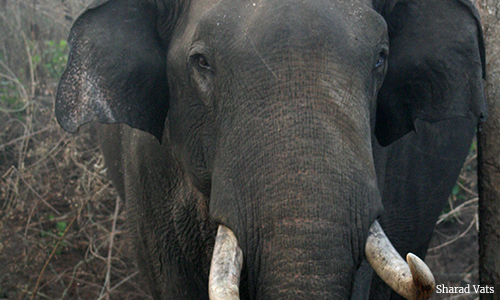Nagarhole is a fascinating tract of wilderness. Not only is the forest extremely rich and varied in its biodiversity, but it’s also got the backwaters of the Kabini River that run through it, giving it an ethereal landscape. Birders have a field day as Nagarhole is especially rich in waterfowl and a slow ride on the backwaters give you a birds-eye view of the avifauna that is perched on partially submerged tree-stumps mid-water.
Nagarhole has an extremely healthy predator-prey ratio. From tigers to elephants, plentiful deer, and entire clans of primates swinging through the branches as the sun filters through its tall deciduous tree canopy, the park is absolutely delightful. Thick clumps of bamboo and abundant water holes and streams means that it is prime elephant habitat and it’s a terrific place to watch entire herds of elephants in the wild.

Nagarhole is in the Kodagu district of Karnataka in South India. It is part of a critical elephant corridor in the south of the subcontinent that includes Nagarhole, Bandipur, Madumalai and Wayanad.

Topography: Nagarhole is a rich mix of Teak, Rosewood, Sandalwood and several indigenous species of trees. The park is full of rivers, streams, swamps, rocky outcrops, lakes, backwaters, and tanks that give it an ethereal quality.
In Season: Nagarhole is open to visitors year round.
Nagarhole forms part of the critical South Indian elephant corridor, along with Bandipur, Madumalai, and Wayanad. It also has an incredible insect biodiversity.
Nagarhole is a tiger reserve and the tiger and leopard are the key mammalian predators along with the Dhole (wild dog) and sloth bear. It’s abundant water bodies are well stocked with mugger crocodiles who feed on smaller animals that come to the banks to drink as well as birds and fish. The park also has several birds of prey, most notably the Oriental White Backed Vulture, which is a critically endangered species. Jackals, Hyenas, Mongooses and Civets are the other predators in the forest.
Nagarhole has an abundant population of Sambhar, Cheetal (Spotted Deer), the Chausingha (four horned antelope) and Barking Deer, which make a great prey base for the predators. The Gaur (Indian Bison) is plentiful in this forest. Wild Boar and several species of primates are abundant. Giant flying squirrels, Indian pangolins, Mouse Deer and the Black Naped Hare are some of the more unusual herbivores to be found in this jungle.
Nagarhole is an exquisite birding haven. Abundant rivulets, streams, lakes, and the backwaters of the Kabini dam, make it a waterfowl haven. Several endangered species are often sighted here, including Darters, Oriental Ibises, the Grey Headed Fish Eagle and the Red Headed Vulture. Several birds spotted here are endemic including the Malabar Whistling Thrush, the White Cheeked Barbet and the Malabar Trogan among others.
The nearest airport is at:
The nearest railway stations are at:

Trekking – trek through the jungle with a naturalist and enjoy the abundance of bird and small animal life.

Coracle Ride – a coracle is a saucer shaped boat made of bamboo and raw hide. An experienced boatman will take you along the backwaters of the Kabini River, so that you can watch elephants, birds, gharial and other animals that make themselves at home on the river.

Bird Watching – Nagarhole is a birding haven especially for water fowl. A trained naturalist will take you bird watching.

Nature Walk – Take a nature walk with your naturalist and learn more about the flora and fauna of the region.

Elephant Rides – Take a ride through the forest on elephant back. You’ll not only learn about the ways of the jungle, but also about the unique traits of these incredible pachyderms.

Kayaking – The Kabini river is terrific for boating. Kayak through the backwaters and take in life along the riverbanks.

November to February is the best time to visit Nagarhole. In January and February, you can spot migratory waterfowl here.
Winters are pleasant and mild and temperatures hover around 20 degrees centigrade (in the low 70s in Fahrenheit) starting from end October until March. Summers can get very warm and dry and temperatures between March and May can go as high as 35-40 degrees centigrade (high 90s in Fahrenheit). The monsoon is extremely moist and wet as it receives the full onslaught of the south westerly monsoon and this period usually lasts from June until October.
Evolve Back (formerly known as Orange County) :
What we love… the “spirit of the land” ethos that pervades this ecofriendly jungle retreat.
Kabini River Lodge :
What we love… the picturesque location of this charming jungle lodge is right on the Kabini River.
Red Earth Lodge :
What we love… mud walled cottages with private Jacuzzis give it an earthy sense of barefoot luxury.
The variety of activities in this park is the highlight here. In recent seasons there have been regular sightings of Black panthers in the park.